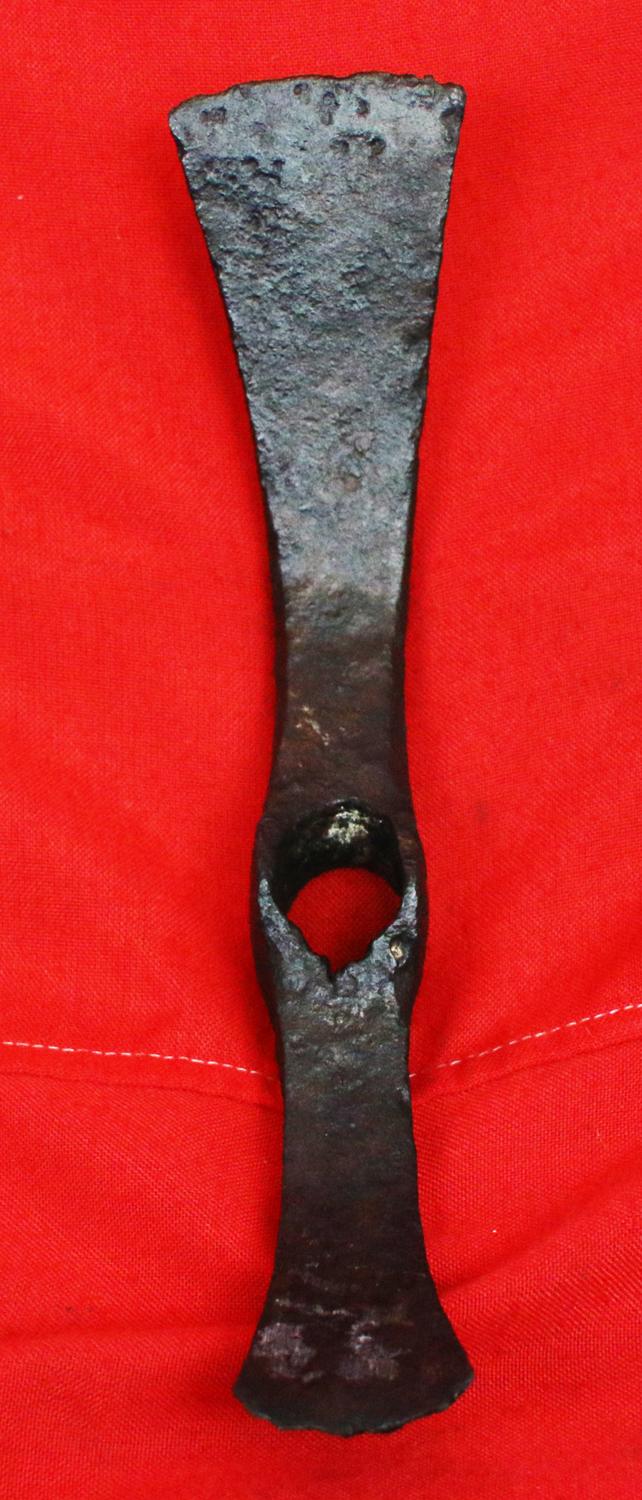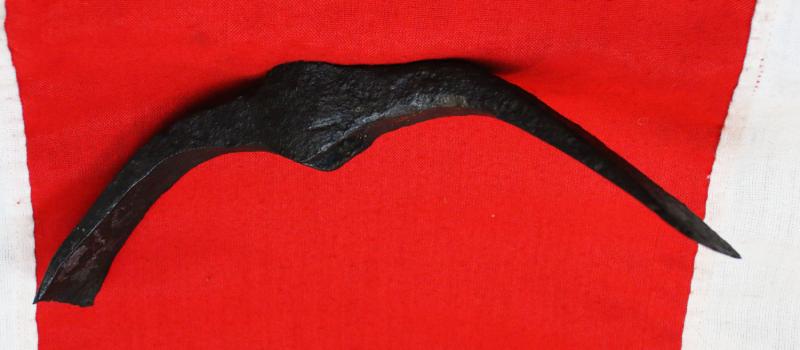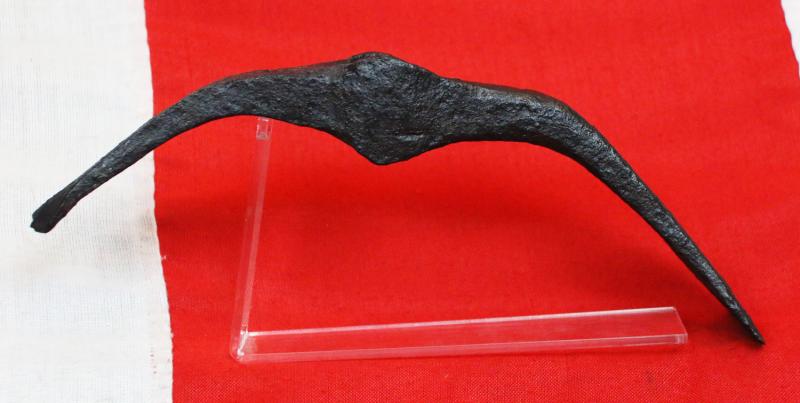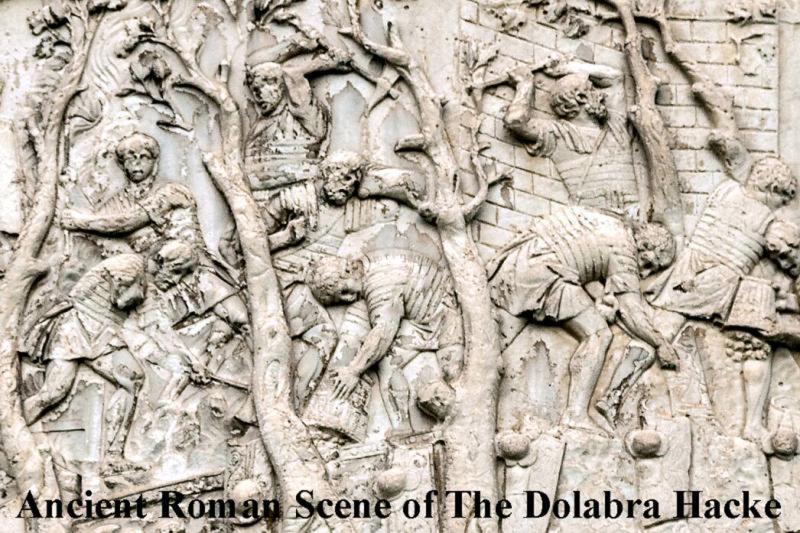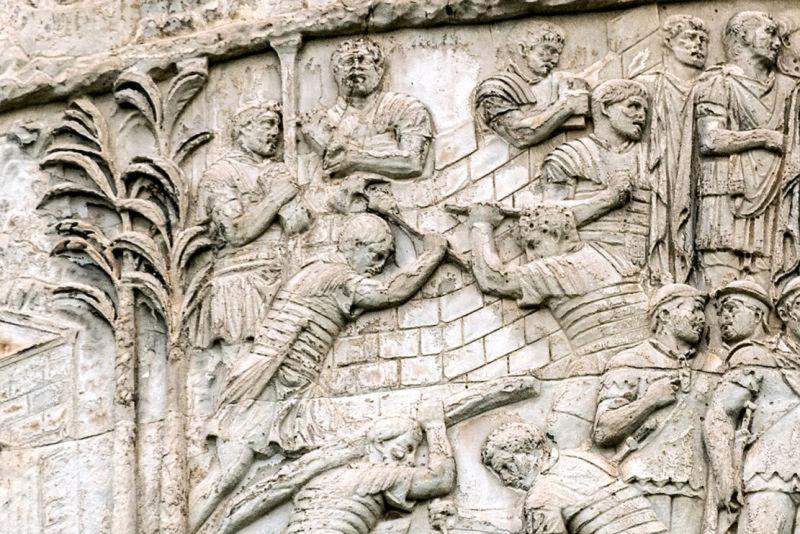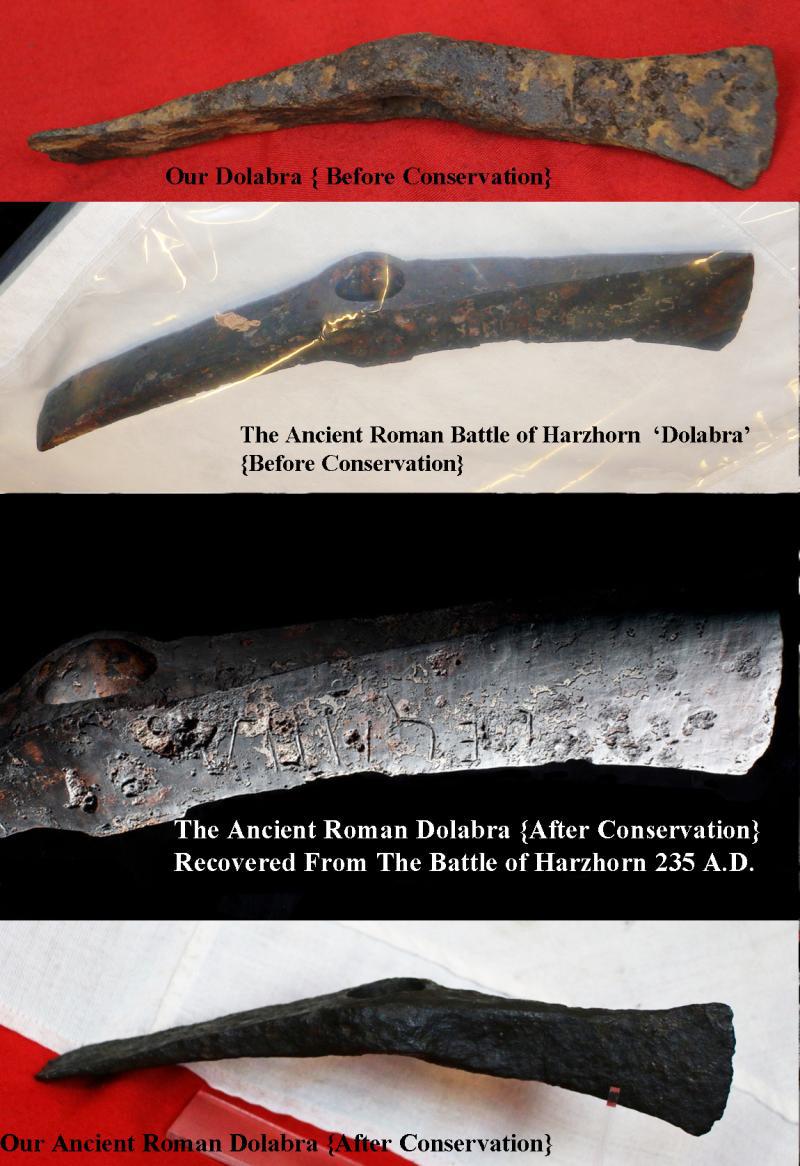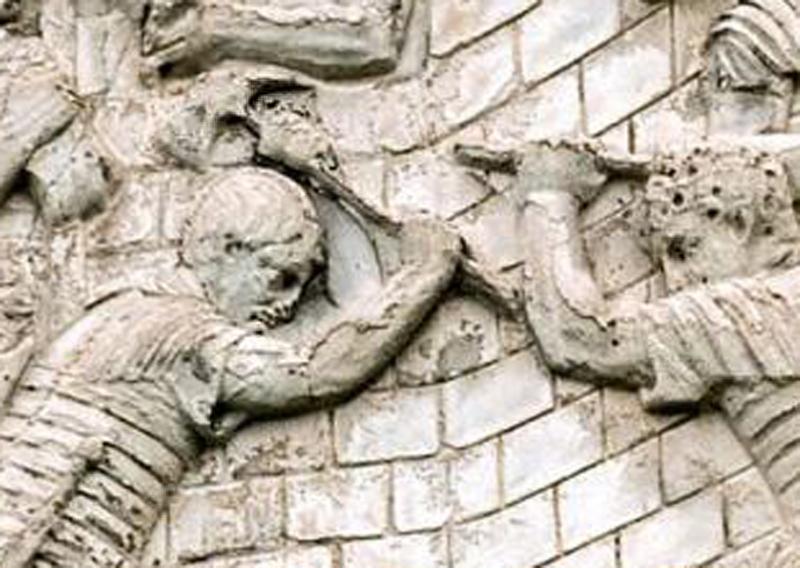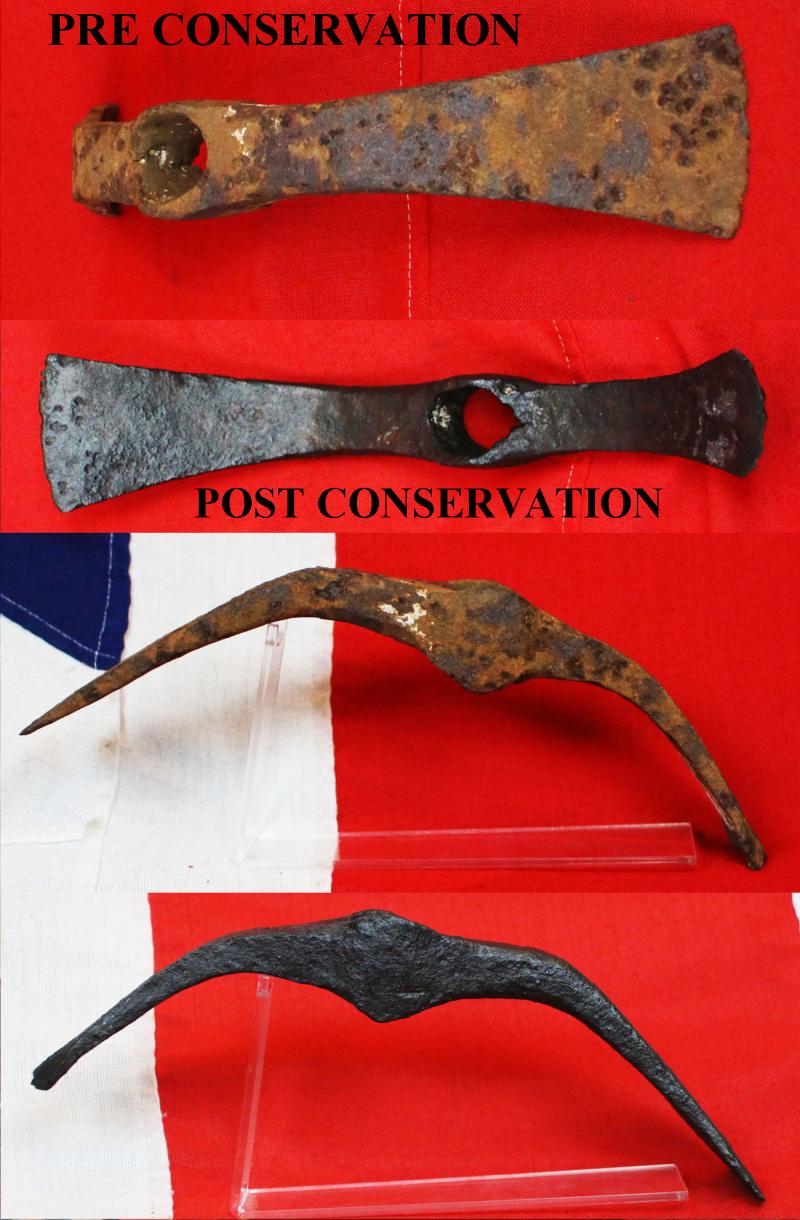A Impressive Ancient Roman Dolabra Pick-Axe. General Gnaeus Domitius Corbulo Once Famously Said Of This Form Of Dolabra, "You Defeat The Enemy With a Pickaxe". Thus It Was Used For Combat & The Destruction of Fortifications. Used From The 1st Century
Gnaeus Domitius Corbulo (Peltuinum c. AD 7 – 67) was a popular Roman general, brother-in-law of the emperor Caligula and father-in-law of Domitian. The emperor Nero, highly fearful of Corbulo's reputation, ordered him to commit suicide, which the general carried out faithfully, exclaiming "Axios", meaning "I am worthy", and fell on his own sword.
Corbulo's early career is unknown but he was suffect consul in AD 39 during the reign of Caligula, his brother-in-law through Caligula's marriage to Corbulo's half-sister Milonia Caesonia.
After Caligula's assassination, Corbulo's career came to a halt until, in AD 47, the new Emperor Claudius made him commander of the armies in Germania Inferior, with a base camp in Colonia (Cologne).
The new assignment was a difficult one and Corbulo had to deal with major rebellions by the Germanic Cherusci and Chauci tribes. During his stay in Germania, the general ordered the construction of a canal between the rivers Rhine and Meuse. Parts of this engineering work, known as Fossa Corbulonis or Corbulo's Canal, have been found at archaeological digs. It ran largely parallel to the modern-day Vliet canal, which connects the modern towns of Leiden (ancient Matilo) and Voorburg (Forum Hadriani). Upon reaching lower Germania, Corbulo employed both the army and naval squadrons of the fleet patrolling the Rhine and the North Sea, eventually expelling the Chauci away from the Roman Provinces and instituting a rigorous training program in order to ensure maximum effectiveness of his legions. He supposedly executed two legionaries after they were found to have laid aside their swords when labouring in the construction of fortifications on a marching camp. Corbulo is famously, purported to have said, "You defeat the enemy with a pickaxe."
The Siege of Augustodunum Haeduorum
Legionaries used dolabrae to defeat armoured crupellarii gladiators.
An instance occurred in 21 AD during the Florus and Sacrovir revolt, where enemy rebels used heavily armored gladiators called crupellarii as their front ranks. The Romans could not pierce the armour of the crupellarii with their swords, so they retrieved their pickaxes and mattocks to batter the rebel gladiators into submission.
In complete condition, without repair and restoration, The form used by Rome for over a 1000 years.
This ancient Imperial Roman utility pick axe (dolabra) was used from the construction of military forts and bridges, to the destruction of enemy fortifications, and it further doubled as an incredibly effective weapon against armoured enemies of Rome, yet just as effective for the tearing down of walled defences. Another iron, axe-adze dolabra was recovered recently from the Harzhorn event, from the time of Emperor Maximinus Thrax 235 to 236 ad .{see photo in the gallery.}
The Roman Battle of Harzhorn ;
The battle between Roman legionaries and auxiliary troops and Germanic tribes around 235 AD on the western edge of the Harz Mountain.
The axe was a fundamental weapon of the Roman to Byzantine soldiers - both on foot and on horseback. Aside from combat, one of the main utility tools of the Roman army was the axe. The pick axe was useful in splitting wood and a fundamental tool needed to do everything from constructing military forts, to building large siege weapons such as catapulta and ballista. In times of war, these axes doubled as highly effective weapons, able to defeat armour, breaking bones and crushing skulls with a single blow and destroying enemy fortifications. This specific long adze axe 'dolabra' was found on an ancient battlefield with a large number of other iron weapons, over a century ago, indicating its final use was in combat. Professionally cleaned and conserved.
This item was used by the Imperial Roman army, and similar versions still used by later Byzantine Roman armies defending the Empire's northern border along the Danube River in the present day East Balkans. This region was the northern-most boundary of the Roman Empire for most of its duration and evolution into Byzantium right up until 1336 AD when the area fell under Ottoman rule. In the Balkans, Roman camps and fortresses along the Danube were constantly being challenged by opposing tribes and armies. The river served as a natural barrier against attacks from the north. Collected from a region that was once occupied by the Byzantine Roman military as they fought against the challengers of the Christian Roman Empire, they were utilized by Roman soldiers in one of the many violent and frequent battles that took place in defense of Byzantium.
The dolabra is a versatile utility axe {either axe -adze, or pick axe} used by the people of Italy since ancient times. This dolabra could serve as a pickaxe, used by miners and excavators, a priest's implement for ritual religious slaughtering of animals, as an entrenching tool (mattock) and also used in Roman infantry combat tactics. In the 1st century CE, at the Siege of Augustodunum Haeduorum, armoured Gallic gladiators were defeated by legionaries wielding dolabrae. The Siege of Augustodunum Haeduorum (modern Autun, France) took place between 269 and 270 AD, during the reign of the Gallic Emperor Victorinus. The city, which had declared allegiance to Claudius Gothicus, was besieged by Victorinus' troops for seven months before being captured and plundered.
Describing the Roman Dolabra.
Gnaeus Domitius Corbulo said, "you defeat the enemy with a pickaxe"
The term Harzhorn event refers to several connected battles that took place between several thousand Roman legionaries and their auxiliary troops and an unknown number of Germanic tribes around the year 235/236 on the western edge of the Harz Mountains on the Harzhorn hill and represent a comparatively late example of the military presence of the Romans in Germania .
The archaeological sites are located near the Kalefeld district of Wiershausen on the northern edge of the Northeim district of Lower Saxony and initially covered an area of 2.0 × 0.5 kilometers (as of April 2009). At the end of 2010, another extensive site was discovered approximately three kilometers away. Both sites are considered by the scientists commissioned to investigate them to be spectacular discoveries of extraordinary scientific importance: Along with the Kalkriese region, they are the best-preserved ancient battlefield in Europe. This offers a unique opportunity to examine the archaeological remains of a Roman army engaged in combat.
To date, around 1,700 artifacts from the fighting have been found (as of summer 2013). Along with the Roman camp at Hedemünden , the Bentumersiel site , the Roman marching camp at Wilkenburg, and the Kalkriese region, the sites around the Harzhorn are one of the largest sites of Roman militaria in northern Germany. This find is also significant because of its context in the historical events at the beginning of the so-called Imperial Crisis of the 3rd century . Previously, historical research had considered such wide-ranging military operations by the Romans to be impossible at this time and in this area. According to current evidence, it is almost certain that the battle belongs in the context of the Germanic Wars of Emperor Maximinus Thrax in 235 and 236.
Dolabrae are mentioned several times in ancient literature, are depicted on the reliefs of Trajan's Column and appear in the finds of imperial military camps, but also in battlefield finds such as in Kalkriese.
Picture 8 in the gallery is of our other Dolabra, identical to one found in a recent excavation at the Imperial Roman Harzhorn battle sites of 265AD, before conservation and after, compared to ours. Picture 10 is this long Dolabra before and after conservation. Note the state of corruption of both dolabra is absolutely identical to the state of iron corruption of the Battle of Harzhorn recovered dolabra, that had remained buried for around 1800 years, just as was ours.
11 inches long measured straight, 14 inches along its curvature. 2 pounds in weight
Every single item from The Lanes Armoury is accompanied by our unique Certificate of Authenticity. Part of our continued dedication to maintain the standards forged by us over the past 100 years of trading
Code: 25811
995.00 GBP

